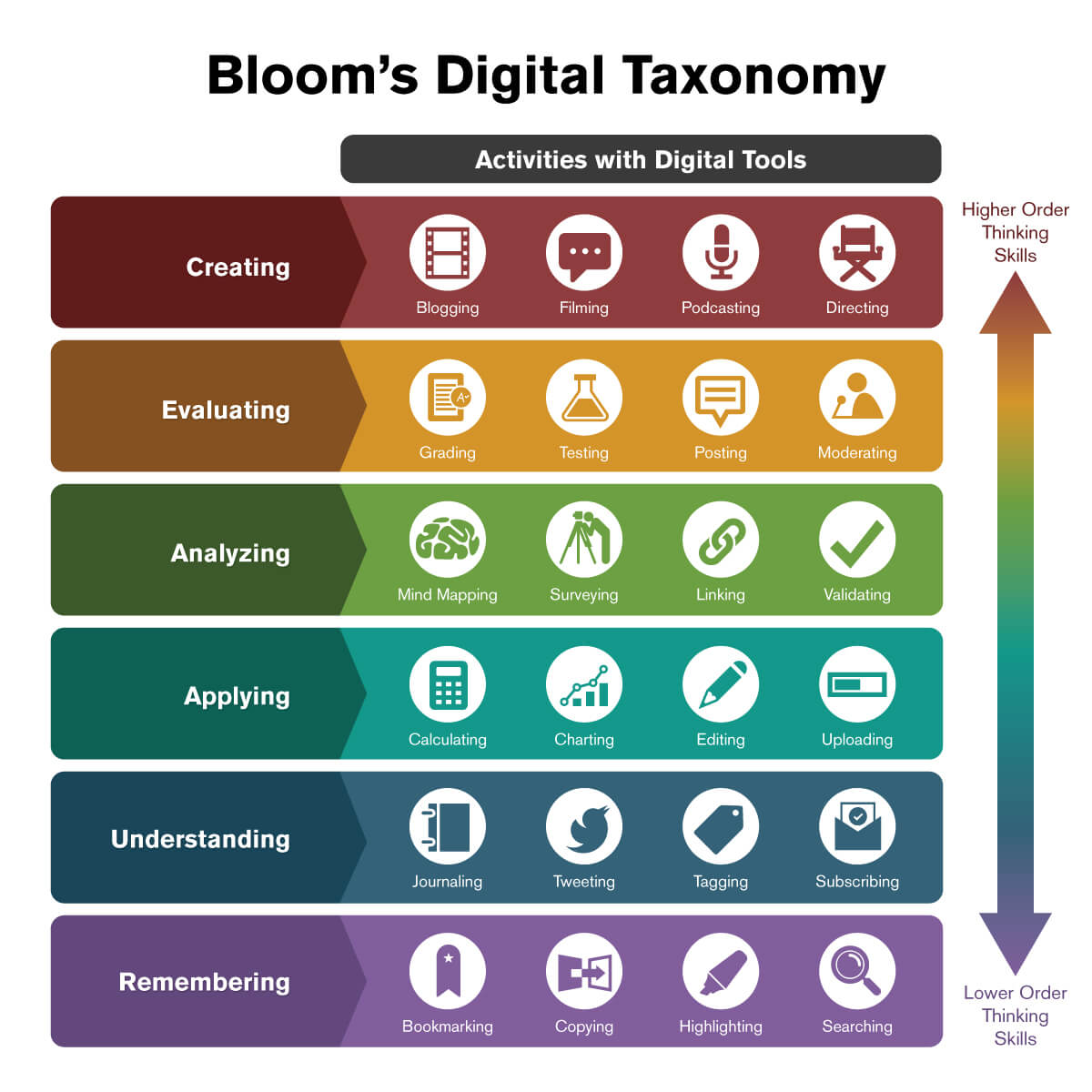
Pam Van Londen, Sr. Instructor, Oregon State University's College of Engineering
Larry Page and Sergey Brin named their first search engine, Backrub, in 1995. They renamed it Google, which is a play on the word googol, a mathematical term meaning a number too large to comprehend.
Google's search box has become a powerful dictionary and encyclopedia over the last 2 decades. You can type: define [word] and get an instant answer! Ask Google to define learning, and it'll tell you that it is, "the acquisition of knowledge or skills through experience and study..."
In the class, you'll do just that...gain knowledge through reading, writing, and discussion, as well as by creating projects that demonstrate skills needed for future courses and employment.

Many of the lessons will require higher-order thinking skills, which you can see from New Zealand author Andrew Church's Bloom's Digital Taxonomy (2007) will include Creating, Evaluating, Analyzing, and Applying knowledge and skills, rather than merely Understanding and Remembering facts (like might occur when presented with a bullet-point lecture).
To merely learn a fact so you can choose it on an exam is low-order learning. Employers in your future will want you to take limitations, look at them from many sides, evaluate, and communicate/present them in a professional manner. So that is what we'll practice in this course.
Regardless of each student's level of expertise (or lack thereof) with computers and software, their cognitive style will affect how they react to the lessons. Researchers at OSU have been studying cognitive heiristyc styles of learning to help students understand eachother so they can work better together.
In Richard Baraniuk's (Rice University), TED Talk, The birth of the open-source learning revolution (2006), he recommends we "cut out the middleman of textbook publishing" and instead, create a "knowledge ecosystem" where we can become our own "educational DJs."
Baraniuk's teaching philosophy, which I share, is that teaching is about creating "interconnection of ideas." I guide students through a process where they discover new concepts themselves through research. When students broaden or narrow their searches to meet a set of guidelines or requirements, they are connecting ideas. When they write about those new ideas in their own words, they are synthesizing that material. This form of learning may induce struggle or take more time, but it ensures students retain what they learned, as noted by Carol Dweck on Struggle.
The role of a teacher is to arrange victories for the studentsMarcus Fabius Quintilianus, Roman Rhetorician
As an online instructor, my job is to facilitate this learning process. I've provided experiences to jump-start the work of researching devices, history, events, people, companies, tragedies, buzzwords, laws, acts, and countries, etc. The experiences (projects) will be what John Green, author of Nerd's guide to learning everything online, refers to as not a set of "arbitrary hurdles but points on a map to see more maps." I will provide a map and you will find more maps!
In a 2011 study, Designing for Productive Failure, authors Kapur and Bielaczyc determined that there is a "hidden efficacy" when groups solve problems together. They begin to understand not just correct solutions, but the structure of solutions, and they outperform those that participated in overly prescribed teachings. This notion that students working together to solve problems is better than the standard lecture/test format is why I've structured the course the way I have.
I like the idea that students create content that is meaningful to them. In some of my courses, you will share your writing, collaborate and review others' writings to improve it, then analyze the major issues in discussion. I call this crowdlearning. In some of my other courses, you'll be encouraged to learn skills together...side by side. This option allows immediate feedback when you need clarification.
In 2008, Jeff Howe coined the phrase Crowdsourcing and talks about its power in, Why the Power of Crowdsourcing is Driving the Future of Business. Crowdsourcing takes the notion of open-source and applies it to any field outside of computer science, such as research and reporting by journalists, scientists, and other authors. A company called Crowdlearn uses the notion as their business model. Other startups are following their lead. Crowdlearning has become a common way to learn.
How education is delivered and received is changing rapidly and many students prefer the new ways of learning, such as through crowdlearning, TED talks, Khan Academy, and Code School. Or by working together with others to solve a problem...making new discoveries. About 10 years ago, I heard about the Minimally Invasive Education (MIE) pedagogy created by Dr. Sugat Mitra. His delivery system for MIE is the Hole-in-the Wall Education Project (HIWEP), wherein under-served communities are provided a computer in a public wall area, so that anyone can step up to the wall and learn whatever they want. Students began to teach themselves and each other. "That children could learn on their own, was something not many people would have imagined and that too in such a cost-effective manner with benefits like improved group dynamics..." (Mitra 2007) This project now has computers in walls in more than 24 locations in India and Cambodia. The initial 4-year study shows improvement in not only test scores, but the assimilation of concepts.
The idea of minimally invasive education is important to me. You'll learn from each other and from many other experts...less so from me. I don't feel that my personal biases are needed for you to succeed in this class, so you won't see me interacting with the group in discussions. In the 17+ years I have been teaching online, I have seen how students teach students quite well without my interference. Your interactions with other students is an effective way to learn a lot of new material.